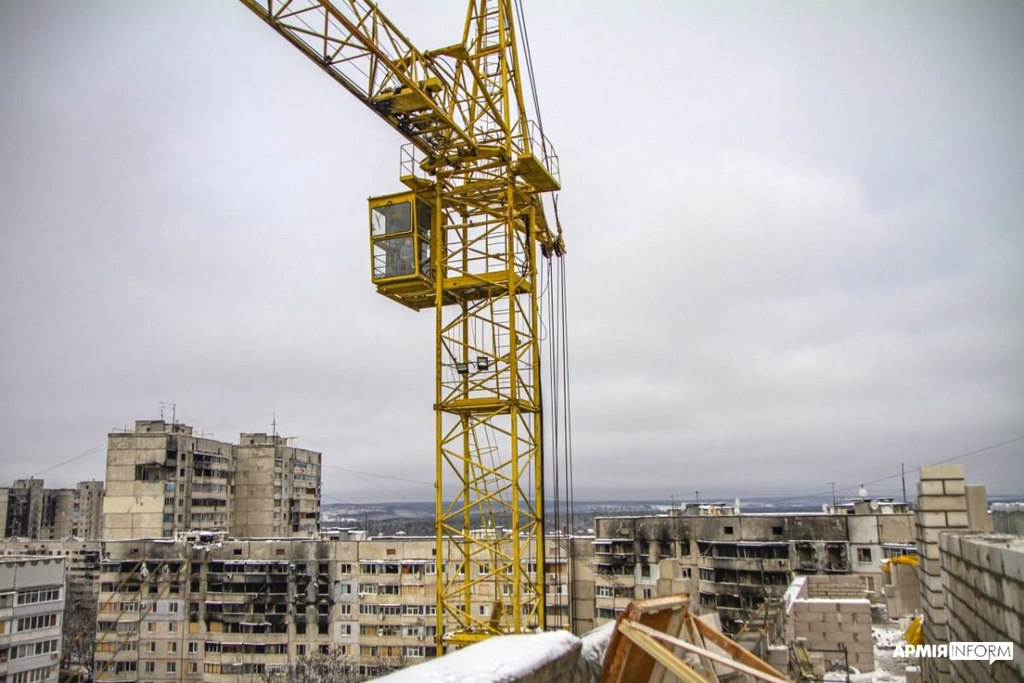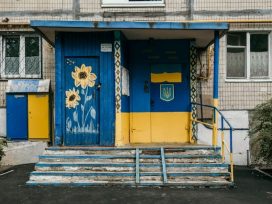Hardened by cold and scarcity
The first year of Russia’s war of aggression and what comes next
Russian attacks on civilian infrastructure are putting the resilience of the Ukrainian people to the test. While attitudes and moods on the home front may prove decisive, the war is in full swing also at the economic level, where the West is fully involved. Almost one year into Russia’s full-scale invasion of Ukraine, here’s what lies ahead.
The withdrawal of the Russian army from Kherson has given Ukraine a morale boost as the first year of the war is nearing its end.
In response to its military defeats, Russia has resorted to attacking the civilian infrastructure. The wanton destruction of power plants and power lines all over Ukraine leaves millions of people in the dark, without heating and running water. In many cities, electricity and hot water are being rationed – and this is only the beginning of a long winter of war.
Over time, cold can wear down the body and affect the mind. Throughout history, the mood on the home front has proven decisive for many wars, including World War I. Russia lost the war in 1917 also because of civilian protests, and Germany eventually had to ask for an armistice because of the domestic situation. The mood on the home front is the second dimension of the current war, and it is just as important as the military developments that Ukrainian and western media cover so extensively.
And then there is also a third dimension to this war: the economy. Here, the West is directly involved. For although it has never been formally declared, western sanctions on Russia add up to an economic war.
These three dimensions are interconnected. Yet, to draw a balance from the first year of war, we need to look at each of them separately.
There is no ‘Ukraine war’
Western media mostly use the term ‘War in Ukraine’ (or German media ‘Ukraine-Krieg’), which is just as misleading as ‘Ukraine conflict’. In terms of contemporary history, this war did not begin on 24 February, but as far back as 2014, when Putin used the turmoil following the Ukrainian ‘Revolution of Dignity’ to annex Crimea and invade the Donbas. From the very beginning, this was a Russian-Ukrainian conflict – and a Russian-Ukrainian war.
This conceptual clarity matters so much because it signifies that the primary problem is not Ukraine, but Russia. The misnaming of conflicts has often had fatal consequences – for example, when the European public lamented ‘minority problems’ in the mid-20th century instead of naming the real core of the problem: the idea of unitary nation states. This intellectual blunder contributed to the mistreatment and extermination of these very minorities – let this be a grim reminder of the weight of their words to all academics, policymakers and journalists who still use the term ‘Ukraine war’.
The first Russian-Ukrainian war began in 2014 and never fully ended. More than 15,000 people died along the ceasefire line in the Donbas since then. Putin used the unresolved territorial conflict as a bargaining chip to block Ukraine’s accession to NATO.
In principle, the defensive alliance cannot accept a new member that is in a state of war because of the obligation to provide assistance. Moreover, the war has deterred investors and has weakened Ukraine economically over the years. Although the Russian strategy was quite obvious, the western sanctions against Russia were half-hearted. Moreover, they were openly undermined by Germany through Nord Stream 2, most of which was constructed after Russia’s 2014 aggression.
The first Russian-Ukrainian war transitioned almost seamlessly into the second Russian-Ukrainian war in February 2022. However, this war represents a new development on all three levels – in terms of the military conflict, the economic impact and the mood on the home fronts.
Back to the battlefields of Europe
First, the military level: the Ukrainian army and civil society put up strong resistance starting right on 24 February, and have been able to repel the attacks on Kyiv and Kharkiv in the North, Mikolayiv and Odessa in the South, and in the Donbas.

Kharkiv after the battle of the city. Northern Saltivka district, the most damaged by Russian shelling. Photo by Оксана Іванець / АрміяInform. Source: Wikimedia Commons.
Neither Putin nor western intelligence services had foreseen such a strong resistance. As early as March, the Russian dictator failed in the first of his war aims: he didn’t manage to occupy a large part of Ukraine nor to overthrow its democratically elected president, let alone install a quisling regime.
The second set of objectives, the conquest of eastern and southern Ukraine, called ‘New Russia’ in Putin’s propaganda, failed along with the great offensive in the Donbas. There, the Ukrainian army turned the tables in the summer and liberated the entire Kharkiv region. In November, the Russian army had to retreat southwards from the left bank of the Dnipro river, and abandoned Kherson, the only regional capital it had conquered in the first year of its second war against Ukraine.
Despite all these setbacks, Russia still seized one minimal war objective: the land bridge to Crimea. Since November, it looks like the Russian army is digging in along the previous front lines in the South. This could create a situation similar to that of the Donbas in the preceding years. Russia could live with that, but not Ukraine, being economically and demographically weakened and kept under pressure by a sustained occupation and permanent threat of further aggression.
While the Russian army has been surprisingly weak, Russia has fared much better in the economic war. This dimension of the war has much wider ramifications, because there the West is directly involved. Russia sees the entire EU, including Germany, as belligerents in the economic war. In the longer term, the sanctions will severely damage the Russian economy, but two factors have limited their impact from the start. The two most populous countries in the world, China and India, did not join the sanctions. NATO member Turkey, and Hungary, Putin’s Trojan horse within the EU, are also undermining them.
It was predictable that Russian countermeasures would hit Germany and the eastern EU states particularly hard. Industries with high energy consumption are already facing major problems. There is a threat of an exodus of production, and even the risk of de-industrialization.
‘Special operation’ and economic war
But there is no way back from the economic war. The West faces a similar dilemma as Russia. Moscow’s ‘special operation’ against Ukraine was never really explained to the Russian population. The same goes for the economic war the West wages. Had this war been publicly declared, the EU would have had to boycott Russian gas and oil on its own initiative. So far, however, the sanctions have been justified primarily on moral grounds – the invasion is a violation of international law, and the genocidal war crimes committed by the Russian army are a decisive piece on the scale.
But a purely normative policy always stands on weak legs, even if the condemnation of Russia’s actions is unanimous. A small advantage amid great adversity is that the energy price crisis – it is too soon to speak of an energy crisis – is offering an opportunity to fast-track a long overdue green transformation that so far has been caught up in the reluctance of European governments, fearing for the momentary performance of their economies.
But however necessary this transformation is, the European economies and civil populations pay a price – even if it pales in comparison with the Ukrainians’ sacrifice. The recession is increasing pressure on the western home fronts, while Russia is benefiting from higher energy prices.
Russian resilience
Europe is made up of many countries, and thus many home fronts. If individual countries start breaking their sanction pledges, there is a risk of a domino effect. This is exactly what Putin is counting on.
And that’s exactly why we cannot count on a quick end to this military conflict. The war has so far been fought almost exclusively on Ukrainian soil, which means that the Russian civilian population can, in principle, continue to live as they did before 24 February. So far the main tolls are the rising number of casualties and the unpopular mobilization of the military, but that can be clouded in the propaganda of a second great patriotic war.
Russian society also has certain advantages in facing a second winter of war next year, because it has experience in dealing with shortages. Due to the socialist scarcity economy and the depression in the 1990s, the population had to acquire survival techniques that are only known in much of Europe by very old people who were children during the last great war. This includes improvising and adjusting when the power supply or mainstream heating fail, an exercise that characterizes Ukrainian everyday life now but terrifies the rest of the continent, even the parts with much more forgiving climates.
Many Russians are capable of finding the means and providing themselves with fruit and vegetables if necessary, and improvising further supplies, just like in Soviet times. In political science, this is called resilience – a quality Russia has shown many times in history.
Ukrainians had similar experiences in late and post-Soviet times and certainly have a stronger motivation to keep fighting for the survival of their nation. Yet, they have the aforementioned disadvantage of fighting almost entirely on their soil, and the economy – already shrunken by around a third – is now being further disrupted by Russian attacks on the civilian infrastructure.

Blackout realities in Kiyv. Author: Anastasia Redchenko. Source: Wikimedia Commons.
It is unclear how Ukraine can continue to finance its war effort, except by printing money, which would cause even higher inflation. Like any dictator, Putin also has the advantage of not having to hold free elections and having almost total control over the media. While he continues to send fake news to the West through social media, little news about the war reaches Russian society.
Although Russia has still not renounced any of its war aims and is committing one war crime after another in Ukraine, there is a lot of talk in Germany and other EU countries about how peace can be restored. But this is a difficult undertaking because Putin is not only concerned with Ukraine. He also wants to restore Russian supremacy within the former sphere of influence of the Soviet Union. That is why he has been demanding the withdrawal of NATO from its latest member states. The concept of this ‘Russian world’ (ruskij mir) threatens the Baltic peoples in particular.
The goals of Ukraine and the West aren’t free of tensions either. At the beginning of the war, when the military situation was quite desperate, Volodymyr Zelensky hinted at giving up Crimea and parts of the Donbas. But since the summer, Ukraine has been confidently demanding the liberation of all of its occupied territories – including Crimea and the eastern Donbas. These demands presuppose further rearmament, which the Zelensky government currently cannot afford.
Will western powers be prepared to finance this, despite a recession and rising inflation? It would be wise in terms of their own security interests. But it would also require political and social consensus. Funding Ukraine’s rearmament would also imply a realization that the EU, and Germany within it, have already become belligerents.
Lessons from this most recent history warn us to always clearly state one’s own goals, to recognize one’s own weaknesses, to never underestimate Putin and to be mindful of a brutal dictatorship’s ability to hang on for a long time.
Supporters of Putin’s regime can still enter many EU countries as tourists. We need a more expansive, intelligent sanctions regime; one which also promises incentives for oligarchs and state officials who oppose Putin. We also need a new diplomacy approach towards those states who depend on western trade and aid, but are breaking sanctions for their own benefit.
And of course, diplomacy is also needed to approach more intelligently a main player in the background: China. It is puzzling why China has so far not used its key role to become a mediator. Perhaps a prospective increase in prestige could persuade Chinese President Xi Jinping to move even further away from Putin.
Finally, Germany and all other EU states face a national task. Much more effort could be directed toward saving energy, because gas exports continue to fill Putin’s war chest. We need to prepare already now for a second winter of war. Twinning arrangements between regions, cities, businesses, institutions and families could help Ukraine, not least to repair the infrastructure destroyed by Russia.
Even though it may sound a bit trite, it is nevertheless true: Ukrainians really are defending Europe’s freedom: they are fighting for their democracy and ours.
Published 28 December 2022
Original in German
Translated by
Edward Maltby
First published by Der Spiegel (German version); Eurozine (English version)
© Philipp Ther / Der Spiegel / Eurozine
PDF/PRINTNewsletter
Subscribe to know what’s worth thinking about.
Related Articles

Ukraine faces its greatest diplomatic challenge yet, as the Trump administration succumbs to disinformation and blames them for the Russian aggression. How can they navigate the storm?

Mineral rush
Topical: Critical raw materials
Why does peace in Ukraine hang on a ‘mineral deal’ whose handling is more reminiscent of trade than negotiations? Perhaps because the global race for critical raw material mining is well and truly underway, digging for today’s equivalent of gold: raw earth elements and lithium critical for renewables and digital technology but also modern weaponry.





